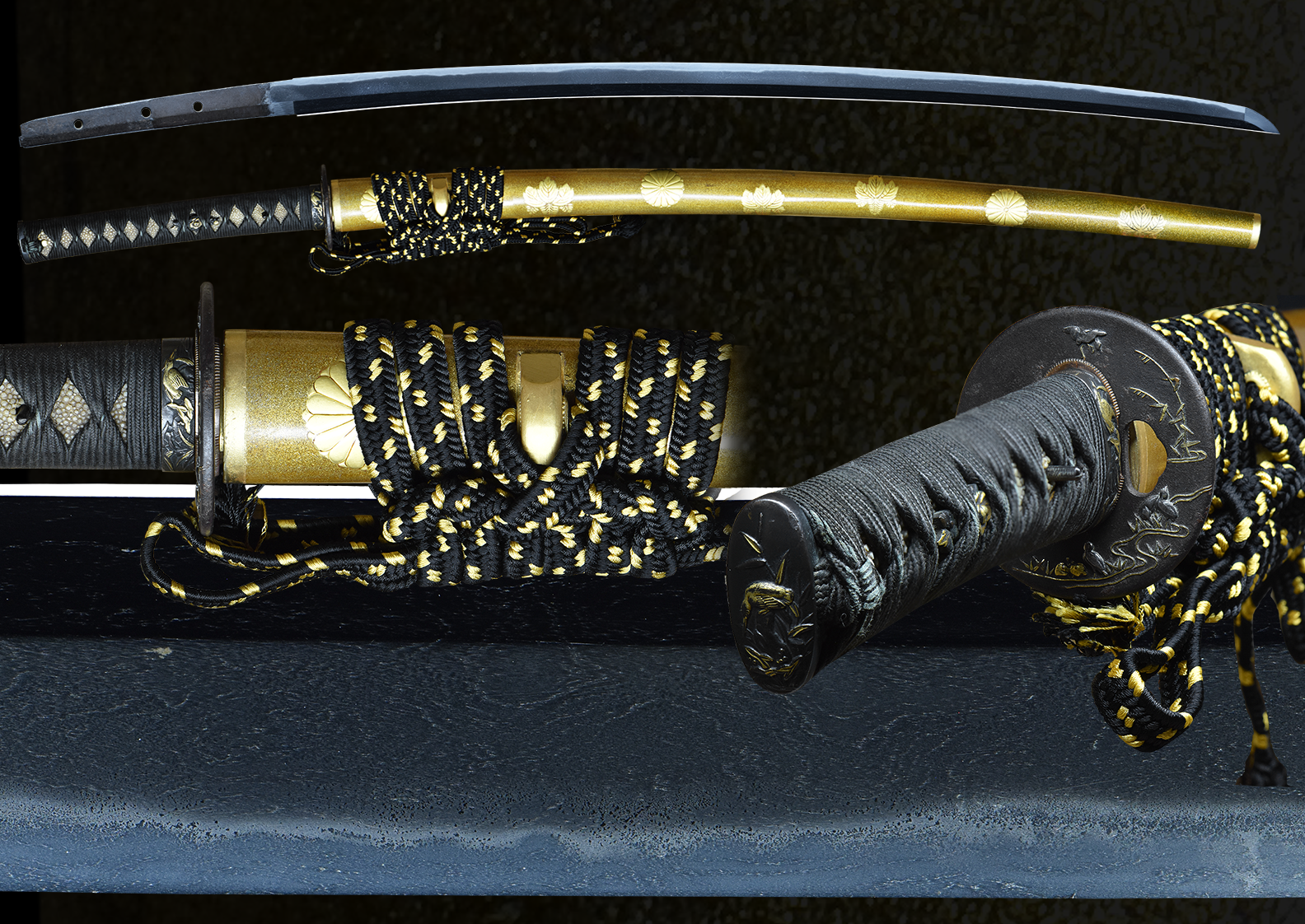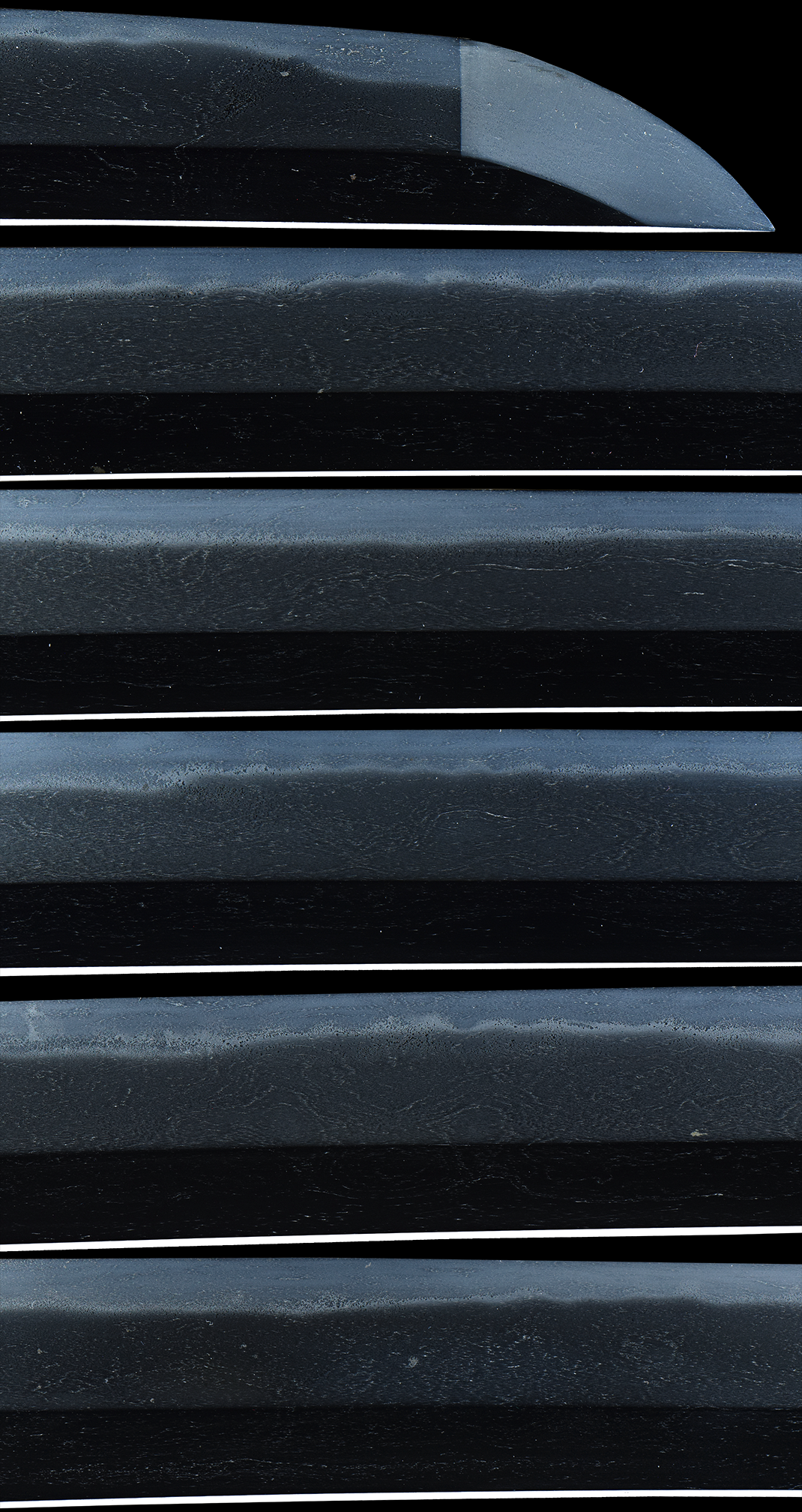A uniques and very interesting blade by Bishu Norimitsu, reminiscent of older slender tachi, this blade is very well balanced and feels good in hand. The Blade construction is Shinogi-zuruki with Iori-mune, The shinogi-suji ridge is fairly high. There is sakizori and a rather deep Koshi-zori. The forging pattern or hada is a combination of Itame-hada (wood grain) and Mokume (burl grain). There is masame grain in the shinogi-suji. Utsuri appears in the ji and is generally found on Bizen school swords. The Tempering pattern is ko-nie based with a clove pattern midare(Choji-ha), it varies in height and shape mixing in with small cloves. The Nie glitters and is vividly bright and the interior of the temper is splendidly active with clove ashi, Sunagashi, yo with streaming and thick Nie that peppers the entire hamon and is covered in ji-nie. The Temper of the kissaki is irregular with hakikake and kaen finish then a small circle turns back.
TheTang (Nakago) is ura-kashi-mei with full signature Bishu Osafune Norimitsu which allows us to know very close to the original length of the blade, the lower half of the back ridge is shaped slightly. There are 3 mekugi-ana with Ha-agari. Katte-sagari (slightly slanting leftward) file marks. The signature is in a long character which is composed of the place of work, Bishu Osafune, and smith name [Norimitsu]. This blade was papered to the Bunmei period Norimitsu which is 1469-1487. This katana is the representative example among works by the finest sword smiths in the Osafune Bizen school in the earlier period of the Muromachi age. NORIMITSU was said to be a pupil of NAGAMITSU which this sword tries to emulate. The active period for him was the end of Kamakura period. Most extant swords of NORIMITSU’s were recognized from Oei 1400s period throughout Muromachi period till 1590s. The subject katana, is considered a work of the 5th or 6th generation NORIMITSU. The entire sword generates a graceful impression of the previous age, unlike stouter works at the end Muromachi period and onwards. The tang was designed for a single-palm grip style and is very well balanced. The saya is a gold suspended in lacquer with raised mons saya and is pure Japanese gold nashiji style. There has been repair done to the saya. This set of fittings are elegant and are in a bird and plant life motif. The sword has recently received papers from the NTHK NPO authenticating the swords signature and quality. We still waiting on final document to come from Japan. They will be forwarded to the new owner. The sword has the NTHK NPO work sheet at the moment that will be sent to new owner as well.
NORIMITSU GORÔZAEMONNOJÔ [BUN’AN 1444 BIZEN] CHÛKOTÔ CHÛJÔSAKU
He is the son of Sukezaemon Norimitsu, and is called Gorôzaemonnojô. There is also a story that Gorôzaemon was a different person, but they were probably the same. He also worked in Sakushû Takatori no Shô. Since there is a blade with “BUNMEI KYÛNEN NANAJÛISSAI” (72 years old, Bunmei 9) added, it is known that he left works from the latter years of Ôei to Bunmei. He made many sunzumari katana and musori sun‑nobi tantô. Hamon is sugu or gonome choji. (Ryôwazamono)
Signatures: BISHÛ OSAFUNE GORÔZAEMONNOJÔ NORIMITSU
BISHÛ OSAFUNE NORIMITSU
BISHÛ OSAFUNE SAEMONNOJÔ FUJIWARA NORIMITSU
Plate I: NORIMITSU
Plate II: BISHÛ OSAFUNE NORIMITSU
Plate III: EIKYÔ GONEN NIGATSU HI
Page 273
Plate I: BUN’AN GONEN NIGATSU HI Ô HATTA KIYOMASA
Plate II: BISHÛ OSAFUNE GORÔZAEMONNOJÔ NORIMITSU
Plate III: BUNMEI KYÛNEN JÛNIGATSU ?
Plate IV: BISHÛ OSAFUNE SAEMONNOJÔ FUJIWARA NORIMITSU, SEINEN NANAJÛNI (Lived 72 years)
Page 274
Plate I: BISHÛ OSAFUNE NORIMITSU, ÔNIN GANNEN SANGATSU HI
Plate II: BIZEN KUNI JÛ FUJIWARA NORIMITSU KATSUMITSU SAKU Caption: NORIMITSU KATSUMITSU GASSAKU (Jointly made)
A regrettable circumstance, the portion above Norimitsu’s signature has been rubbed off. Katsumitsu is the Ukyônosuke Katsumitsu, and this was made around Bunmei. The size of the signature characters was influenced by the shinogi line. In the event a groove was cut and ran as far as the nakago and such, there are times when a larger signature than usual is cut in the hiraniku.
Plate III: GONOME CHOJI
Gonome choji nioi shimaru. This is a style that is seen in Ôei Bizen and the early period of late Bizen. The period after Ônin, in which we enter the Sengoku Jidai, is called late Bizen, and the period before that is called Ôei Bizen. Norimitsu stands astride both of these, but more of his works fall into the Ôei Bizen period.
- Mei: BISHU OSAFUNE NORIMITSU
- Date: BUN’AN (1444)
- Nagasa: 26-1/4 inches
- Sori: 18.0 mm
- Width at the ha-machi: 25.4 mm
- Width at the yokote: 15.7 mm
- Thickness at the mune-machi: 6.1 mm
- Construction: Shinogi zukuri
- Mune: Iori
- Nakago: Ubu
- Kitae: Itame/mokume
- Hamon: Midare Gunome
- Boshi: hakikake and kaen
- Condition: Good polish
(shipping and insurance included)
Email us if your interested in this item and remember to include the order number for this item: fss-931.
Click to Enlarge Image
This sword recently passed the NTHK NPO Shinsa.
We have the work sheet from the shinsa in hand.
We will send final documents to the new owner the moment we receive them.
For Sale

























